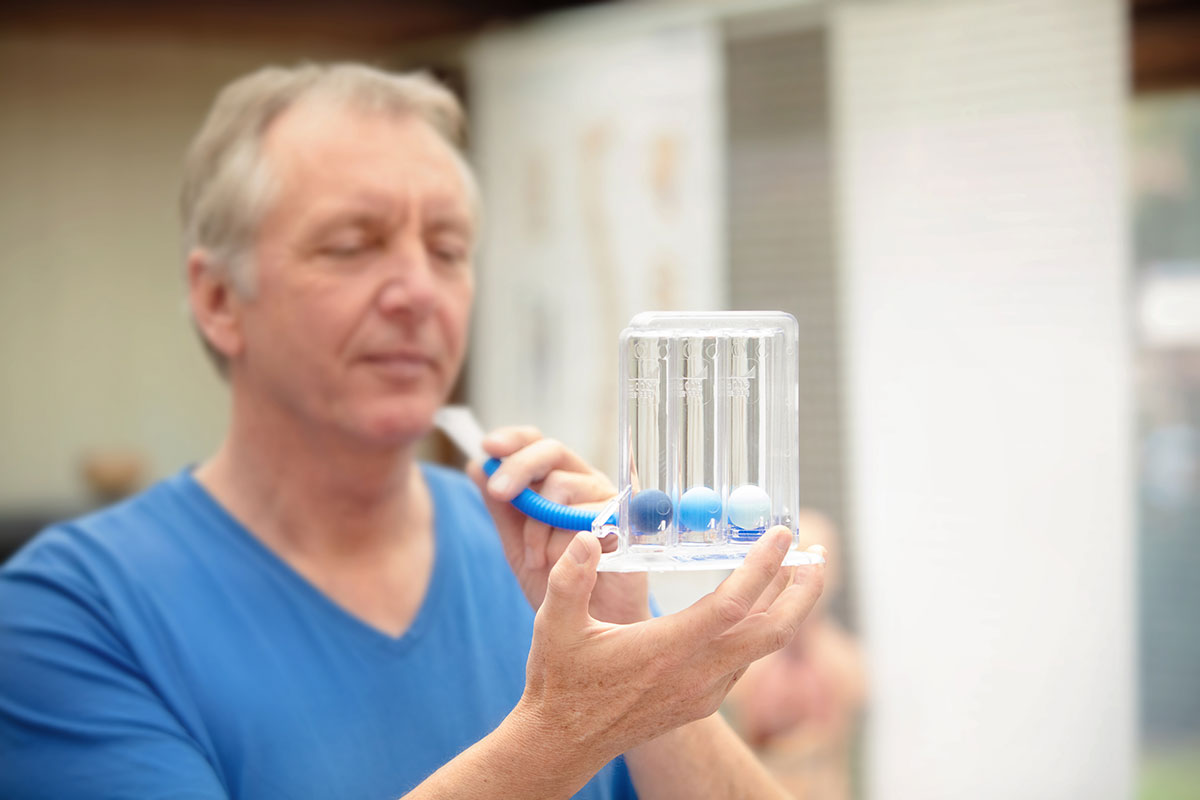What does pulmonary mean?
Pulmonary is a medical term referring to the lungs. Pulmonology is a medical specialty focused on diseases that involve the lungs and respiratory system. The definition of pulmonologist is a physician who specializes in pulmonology. Among the many instruments for a lung function test is a device called a spirometer, or pulmonary function test (PFT) machine, which measures airflow capacity both into and out of the lungs. Testing with a spirometer is among the simplest of pulmonary function tests, which some patients call a “breathing test.”
What does a pulmonary doctor (pulmonologist) do?
A pulmonologist is a physician who specializes in the function of lungs and the respiratory system. They also study and treat diseases affecting pulmonary function. Interpreting your pulmonary function test is one of the most important first steps a pulmonologist will take in evaluating and developing care treatment plans.

What is a pulmonary function test?
Pulmonary function testing (PFT), refers to a group of tests that measure how well your lungs are performing. One of these is called a spirometry test, which measures the ability to inhale and exhale. Pulmonary tests are often performed to diagnose certain types of lung disease such as bronchitis, asthma, emphysema, or chronic obstructive pulmonary disease (COPD). However, there are other reasons that someone may suggest a PFT. You’ll find PFT testing capabilities at a FastMed near you. If your physician has told you to get a PFT, and you’re not sure what to expect, we’re happy to help.
How does a spirometer work?
Spirometers are common medical devices, and come in all shapes and sizes. They may be plugged into a computer, or have their own display screen. But they all have one thing: an attached tube. When you have your spirometry test, the healthcare provider will ask you to breathe into the tube. The rate of inhalation and exhalation, the lung capacity, and the total amount of exhalation will be measured. All of these measurements help a physician diagnose and treat conditions in your respiratory system.
What does a pulmonary function test reveal?
A PFT helps providers diagnose specific lung diseases by testing respiratory (lung) volumes and capacities. After spirometry testing, a total lung capacity chart will show whether the patient’s lungs perform at normal values or not. Besides diagnosing diseases, a PFT may be suggested to find the cause of shortness of breath, measure whether exposure to certain chemicals affect lung function (especially in people who are exposed to chemicals as part of their job), or to monitor lung capacity and function before surgery.
How long does a pulmonary function test take?
A spirometry report is a simple test that will take only about ten minutes in most cases. At FastMed, we’re committed to providing accurate, convenient, and affordable pulmonary tests and procedures. A FastMed with PFT capabilities is available near you, right when you need us. To locate the closest location, check out our FastMed Office Finder.
How should I prepare for my pulmonary function test?
Patients should avoid smoking for at least four hours before the test, and avoid exercising 30 minutes before the test. Eat light for the day before you arrive at the testing location. Patients on inhaler medications should ask their healthcare provider for specific instructions regarding PFT preparation.
How many pulmonary function tests are there?
Spirometry measures the function of airflow and evaluates a range of lung diseases by recording the rate of air you breathe in and out. Lung volume measurement requires a patient to sit in a sealed area that actually resembles a phone booth while breathing into a mouthpiece that measures lung volume. For diffusion capacity measurement, the healthcare provider may have you breathe in a tracer gas for one short breath to estimate how well your lungs move oxygen from the air into the bloodstream. Some patients may refer to all the above tests as a “breath test.”
What is the respiratory system?
It is the system that your body needs to breathe, consisting of three parts: the airway, the lungs, and the respiratory muscles. Lungs are the primary organ for breathing. The airway includes several body parts in the head, throat, and chest that allow for inhalation and exhalation. Your respiratory muscles also help with the motion necessary to inhale and exhale.
* The content presented on this page is not intended to diagnose health problems or take the place of professional medical care.